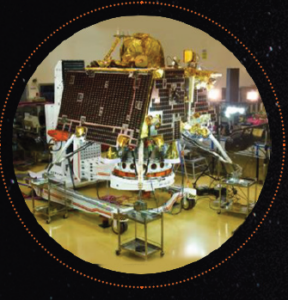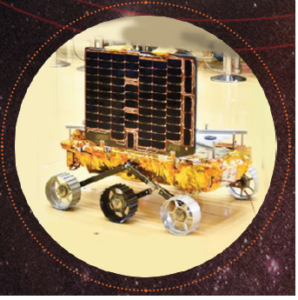
by Rashmi M
On July 14, 2023, the Satish Dhawan Space Centre (SDSC), SHAR, Sriharikota, popularly known as the Spaceport of India, was bearing witness to one of ISRO’s (Indian Space Research Organisation) most ambitious mission – Chandrayaan 3. The entire nation was bracing itself for the momentous event. At precisely 2:35 pm IST, the highly anticipated launch of Chandrayaan 3 was scheduled to take place. Like many others, I too was eagerly waiting to witness the historic moment through ISRO’s live streaming from Sriharikota. My excitement soared even higher when I saw that the launch view gallery of the SDSC was overflowing with enthusiastic people. This was a testament to the excitement and anticipation generated by this mission as people across the nation were eager to witness it with their own eyes.
According to the details provided by ISRO on their official website, Chandrayaan 3 has primarily three mission objectives. The first objective is to demonstrate a safe and soft landing on the lunar surface. The safe and soft landing on the lunar surface is crucial for ISRO and India, as till date only three countries – Russia, China and the US have achieved this feat successfully. Before proceeding, let’s take a brief look at the predecessors of Chandrayaan 3. These include Chandrayaan 1, India’s first lunar probe launched in 2008, which made significant discoveries and one of its groundbreaking finding was the confirmation of the presence of water molecules on the lunar surface. Though the spacecraft lost its communication on August 29, 2009 but it had far reaching implications for the future lunar missions of ISRO. Chandrayaan 2 was launched on July 22, 2019 and it marked India’s first attempt to accomplish a soft landing near the lunar South Pole. Chandrayaan 2 had three components – an orbiter, a lander and a rover. The lander was named Vikram in honor of Dr. Vikram Sarabhai, the father of the Indian Space Progamme. The rover was named as “Pragyan” which translates to ‘wisdom’ in Sanskrit. Unfortunately, the communication with the lander was lost shortly after its separation from the orbiter, resulting in a hard landing. According to government reports, Chandrayaan 2 ultimately lost its communication after 45 days. Nonetheless, the mission’s orbiter continues to function effectively, providing valuable data and insights about the lunar surface.
As mentioned earlier, Chandrayaan 2 intended a soft landing near the lunar South Pole and the third installment of the Chandrayaan series also seeks a soft landing on the moon’s South Pole. Now, why is this region considered to be a compelling spot by space scientist across the world? Why are global space powers like Russia, China and the USA preparing for space missions specifically focusing on the lunar South Pole? It was fascinating to learn that the moon’s South Pole holds huge potential as a valuable water source and there are certain permanently shadowed regions untouched by sunlight for billions of years which demonstrate its significance in understanding the lunar history. Moreover, this region is undeniably relevant as a strategic location for exploration, establishing habitats and international collaborations for unlocking mysteries that lie within its unexplored frontiers.
The second aim of the Chandrayaan 3 mission is to demonstrate Rover roving on the moon, while the third objective focusses on conducting in-situ scientific experiments. As explained above, Chandrayaan 3 comprises of an indigenous Lander Module (LM), Propulsion Module (PM) and a Rover. The Rover is expected to carry out in-situ chemical analysis of the lunar surface during the course of its mobility. The Lander and the Rover has scientific payloads like LASER Induced Breakdown Spectroscope (LIBS) and Alpha Particle X-ray Spectrometer (APXS) to identify the mineralogical and elemental composition of the lunar surface.

Propulsion Module (Source: ISRO, 2023)
Beyond scientific and technological advancement, this mission represents India’s growing presence in space exploration. Geopolitically, this mission holds great significance, especially in the context of the evolving space race where private enterprises are competing and collaborating with publicly funded space missions in leading spacefaring nations. The successful execution of the Chandrayaan 3 mission will further strengthen India’s position as a space faring nation. The widespread enthusiasm associated with this mission integrates people from diverse backgrounds, fostering a sense of pride. I should also highlight the profound impact of this mission on the nation’s youth. Chandrayaan mission inspires curiosity and a keen interest in pursuing careers and research activities in the field of space science.

Lander Module (Source: ISRO, 2023)
An exciting announcement from ISRO stated that on August 1, 2023, the spacecraft was successfully inserted into the translunar orbit. The next milestone was the lunar orbit insertion, which was scheduled to take place on August 5, 2023. Indeed, expectations are running high, and the excitement is intensifying as the mission progresses. I am definite that this mission has gained global attention, and millions of people around the world are closely watching each stage of this mission. As a space enthusiast, I am eagerly looking forward the historic unfolding of this space endeavor on August 23, 2023.

Rover (Source: ISRO, 2023)
Chandrayaan embodies hopes, dreams and aspirations of millions of Indians. Each space mission brings forth new knowledge and discoveries that significantly expand and redefine our understanding of outer space. There is immense global anticipation for upcoming space missions of India and other space powers like Gaganyaan, which envisions India’s first human spaceflight programme, NASA’s Artemis and China’s next generation crewed spacecraft. With collective hopes, and best wishes, India is determined to push the boundaries and witness the remarkable achievements that lie ahead in the realm of space exploration and the contributions they will make to humanity’s understanding of the universe.
References
- Indian Space Research Organisation. (2023). LVM 3-M4/Chandrayaan-3 Moon Mission.ISRO.https://www.isro.gov.in/media_isro/pdf/Missions/LVM3/LVM3M4_Chandrayaan3_brochure.pdf.
- ISRO Official. (2023, July 14). Launch of LVM3-M4/CHANDRAYAAN-3 Mission from Satish Dhawan Space Centre (SDSC) SHAR, Sriharikota [Video]. YouTube. https://www.youtube.com/watch?v=q2ueCg9bvvQ.
- Naaz, F. (2023, July 18). Mission moon: China to launch next-generation crewed spacecraft as early as 2027.| Mint. https://www.livemint.com/news/world/mission-moon-china-to-launch-next-generation-crewed-spacecraft-as-early-as-2027-details-here-11689667693777.html
- NASA: Artemis. (n.d.). NASA. https://www.nasa.gov/specials/artemis/

